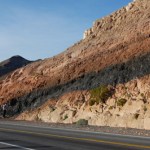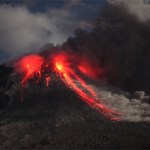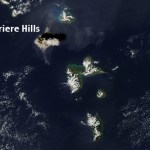Soufriere Hills
So, I'm a little late with this thanks to a little hiatus, but I thought I would post the latest GVP Weekly Volcanic Activity Report. Thanks again to the Smithsonian, USGS and especially Sally Kuhn Sennert!
Some highlights include:
There were more ash explosions spotted at Ebeko in Kamchatka, producing ~1.8 km (5,900 foot) ash columns. This activity prompted KVERT to raise the Alert Status to Yellow. This goes along with news from a pile of other Kamchatka/Kuril Island volcanoes: Gorely, Tiatia, Karymsky, Kliuchevskoi and Shiveluch.
More activity at Arenal in Costa Rica - its almost always…
The latest news from the world of volcanoes, brought to us by the Global Volcanism Program, USGS and the Smithsonian Institution. They are also brought to us by Sally Kuhn Sennert - and if you have a question for her about her job at the GVP preparing the Weekly Volcanic Activity Report and all things volcanic (and hopefully it won't end like another recent volcanically-mitigated interview).
Some highlights (not including Gorely and Sakurajima):
Ioto (aka Iwojima) in the Volcano Islands of Japan produced an ash plume of unknown height. The volcano has frequent phreatic eruptions and abundant…
Hard to believe, but there is other volcano-related news in the world ...
So, with all deference to Eyjafjallajokull, here it is:
Dome collapse on Colima in Mexico, image taken March 30, 2010.
The new Smithsonian/USGS GVP Weekly Volcano Activity Report was issued, with news about increasing signs of activity at Egon in Indonesia, a possible plume at Miyakejima in Japan and more dome growth at Soufriere Hills.
A study on the economic effect of a new Vesuvius eruption was released and the finding show the potential for a staggering $24 billion of economic damage directly related to an…
I'm still playing catch-up after my week in the desert, so I've seen a lot of articles I've wanted to mention ... but a certain other volcano has taken up a lot of my time. However, I will attempt to make amends for that now.
By the way, would you believe Ubehebe Crater was closed? How do they close a volcano, anyway? However, I did get a great snap of a welded tuff on the road outside of Shoshone, CA.
A strongly welded tuff near Shoshone, CA. The dark interior is remelted volcanic ash/tephra surrounded by less welded pink tuff with abundant pumice clasts. Denison student David Sisak is on…
Catching up with some news:
Anatahan erupting in the northern Mariana Islands in 2003.
I ran across this article right before I got sick, but its been popping up around the interwebs (and is pretty interesting). It details a study in Molecular Ecology that suggests that populations of caribou in Canada's Yukon Territory were strongly effected by the White River Tephra. The White River Tephra is supposedly the largest Holocene plinian tephra (from a ash cloud fallout), with two components dating from ~1900 years ago and ~1250 years ago. The vent for the WRT is likely from a vent beneath the…
Not a lot of big news, but a lot of little news:
Soufriere Hills at night during the late January 2010 dome growth episode. Note the hot rock falls from the collapsing dome. Image courtesy of Photovolcanica.
This might not be new, but Dr. Boris Behncke brought the new webcam at the rim of Chaiten in Chile to my attention. You get a birds-eye view of the growing dome from the edge of the caldera - pretty nifty view for a once-in-a-hundred-years sort of event.
The NASA Earth Observatory has posted a close-up of the Soufriere Hills imagethat I posted yesterday, showing the February 11 plume.…
A couple bits of news:
The ash plume from the February 11, 2010 eruption of Soufriere Hills taken by theAqua MODIS camera. Image courtesy of the NASA Earth Observatory.
Flights have been disrupted in the West Indies since last week with the large dome-collapse eruptions of Soufriere Hills on Montserrat. The 10 km / ~35,000 foot ash plume is apparently lingering in the air at commercial flight levels, meaning delays, cancellations or long detours for many flights in the area. Flights in and out of Dominica, Guadelope, Montserrat, Anguilla, St. Kitts and Nevis have all been effected by the…
Two impressive eruptions going on right now:
Soufriere Hills erupting on February 11, 2010. Image courtesy of the Montserrat Volcano Observatory.
Soufriere Hills just keeps on raising the bar during its new eruptive period. The volcano on Montserrat in the West Indies produced a 15 km / ~45 000 foot ash plume as the summit dome partially collapsed again. It was one of the biggest volcanic events at Soufriere Hills in the last 15 years, with 10-15% of the dome collapsing. One of the regional airlines in the West Indies have had to cancel flights due to the ash that has mainly been heading to…
Sally Sennert from the Smithsonian Institution sent me an email to say that this week's USGS/Smithsonian Institute Weekly Volcanic Report will be delayed due to the inclement weather in the Washington DC area. She can't connect with the server, so the report can't be updated on the Smithsonian website ... so here it is! Look for it to show up on the Smithsonian site with all the bells and whistles as soon as DC thaws out.
And a big thanks to Sally for sending me the Report to post.
***PLEASE NOTE: Website posting of the SI/USGS Weekly Volcanic Activity Report for 3-9 February 2010 will be…
A pyroclastic flow from the February 5 vulcanian eruption of Soufriere Hills. Image courtesy of the Montserrat Volcano Observatory (MVO).
UPDATE: See some amazing images of the recent eruptive activity over on Stromboli Online. {Hat tip to the Volcanism Blog via Eruptions reader CK.}
One event that didn't eat much coverage over the weekend, at least here in the U.S., was the large eruption and explosions at Soufriere Hills on Montserrat. The volcano has had a resurgent winter since have a quiet summer of 2009. This weekend's eruption produced an ash plume that reached ~6.1 km / 20,000 feet…
News!
Pakistan is home to the world's tallest mud volcano in the region of Balochistan - and its somewhat near the reports of an "eruption" earlier this week.
Guess what? Since Wednesday evening, seismicity at Yellowstone has dropped precipitously. The last batch of earthquakes on February 3rd were also back to deeper levels - 8-9 km depth - compared to the potential shallowing earlier in the week. I'm sure the caldera will keep us on our toes, but as of now, it seems to have settled down a bit.
Over in Pakistan, there is mounting evidence that the recent "volcanic" eruption reported as, in…
Some news for the last Friday in January:
Volcanic lightning captured over Redoubt in March 2009.
Tungurahua in Ecuador continues to erupt. Yesterday, the volcano spread ash over much of central Ecuador. Apparently people in Ecuador aren't taking the hazard of ash too seriously, with many ignoring recommendations to wear masks when the ash is falling. Over 50 explosions have been recorded over the last 24 hours at the volcano according to the Ecuadorian Instituto GeofÃsico, most of them small to moderate.
We also have a new USGS/Smithsonian Institute Volcano Activity Report. Much of the "…
The weekly volcano report, brought to you by our friends at the Smithsonian Global Volcanism Program and the U.S. Geological Survey.
Highlights (not including Mayon, Nyamuragira and Turrialba):
Eruptions continue at Piton de la Fournaise on Reunion Island - heck, this would be the volcano news if it wasn't for all these other, more explosive systems getting in the way. Lava fountains, flows and pools were the order of the day in the SW Dolomieu crater until the 12th of January.
Chaiten in Chile continues to chug along - block-and-ash flows were seen and ash plumes continue to emanate from…
Somehow I haven't posted a bunch of interesting items collected over the last few weeks, so I need to catch up. A pre-emptive hat tip to everyone who has sent me links or notes that might seem familiar in this post.
Tungurahua in Ecuador erupting in 2000.
First off, those of you looking for information on the Haitian earthquake that devastated the capitol Port Au Prince, Highly Allochthonous has post on the tectonics of the quake. Right now, it is hard for me to come up with a worse location in terms of devastation for a quake to have hit in the Caribbean Basin.
Back in volcano news, a lot…
The steam plume from Turrialba on December 26, 2009. Image by Eruptions reader Sahrye Cohen.
Turrialba
Costa Rican officials extended the evacuation zone around Turrialba from 3 to 6 km, raising the alert status at the volcano to Yellow. Vanessa Rosales of the National Emergency Commission described the seismicity as "intense but low," but says the country is prepared to deal with the emergency. As always, the news chooses oddly what is the "news" of an event, and many article on Turrialba focus on Costa Rica's coffee - yes, it is safe, so far. A news report from the Tico Times quotes Raul…
2009 is over! If you missed the Volcanic Year in Review, check out my summary of the volcanic events that captivated many of us over the past year. However, only one event will get the coveted 2009 Pliny for Volcanic Event of the Year. A lot of you wrote in with votes and comments - I thank you - and a number of events stood out in your mind. Here we go:
Honorable mention
A few volcanic events got multiple votes:
- Soufriere Hills on Montserrat.
- Mando Hararo in Ethiopia.
- Chaiten, Chile and the new research on the eruption.
- The earthquakes in western Saudi Arabia under the Harrat…
Here it is, my attempt to recap a year's worth of volcanic events. By no means is this supposed to capture every event, but rather the highlight/lowlights and what most captivated me during 2009. I'll be announcing the winner of the 2009 Pliny for Volcanic Event of the Year tomorrow.
Waimangu Geothermal Valley in New Zealand, taken in January 2009 by Erik Klemetti.
January
The year started out with a trip to New Zealand (well, for me at least) and vistas of the Waimangu Valley, formed in the 1886 eruption of Tarawera on the North Island. We were also still thinking about the late 2008…
Soufriere Hills on Montserrat in an undated image from the Royal Navy.
Just wanted to pass along this bit of news: the current eruptions at Soufriere Hills on Montserrat are prompting cancellations of over 40 flights today from Puerto Rico. This is due to the ash plumes from the current dome eruptions - the NASA Earth Observatory posted images of the recent activity showing the large, grey plume drifting to the west. What is impressive is that Puerto Rico is over 250 miles / 400 km to the west of Montserrat, so this ash must be significant enough to prompt these flight cancellations. The ash…
Before it gets lost in the mists of time/finals, here is the weekly volcano report brought to us by the USGS and the Smithsonian Global Volcanism Program.
Highlights (not including Mayon, Soufriere Hills or Piton de La Fournaise):
Fuego in Guatemala produced ash plumes that reached 4.1-4.7 km / 13,500-15,400 ft along with avalanches of volcaniclastic debris.
Also in Guatemala, lava flows erupted from Pacaya, traveling hundreds of meters from the main vent area.
Manam in PNG produced an 3 km / 10,000 foot ash plume as part of its renewed activity this year.
The lava dome on Nevado del Huila…
It's the last week of classes and it's also AGU (which I will be missing for the first time in 5 years). If you happen to be at the big meeting in SF and hear something you think we'd like to hear, feel free to drop me a line or leave a comment so we can live vicariously through you.
Pyroclastic flows at Sourfriere Hills, December 2009. Image courtesy of MVO.
Some news:
UPDATE 12:40PM 12/14/2009: Just to update the Mayon news from earlier today, PHIVOLC is reporting that lava has been spotting flowing from the main crater on Mayon. Sounds like the eruption we've been waiting for is…



